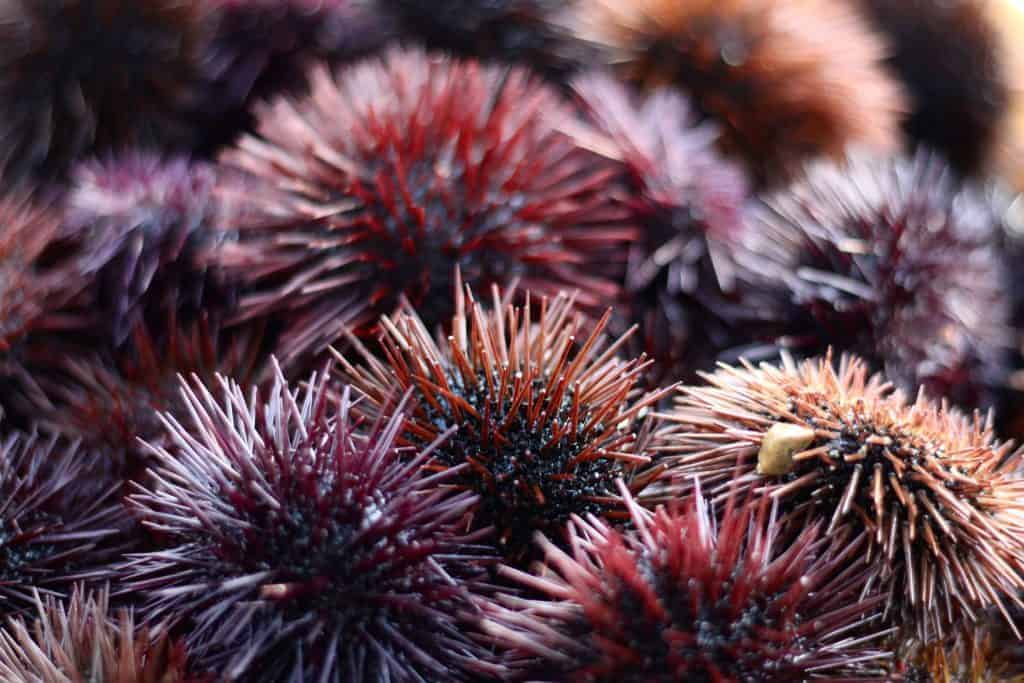Sea Urchin in Foot – What You Should Know
To Remove Sea Urchin Spines From Your Feet
Jay DiMartino is a writer and a former competitive surfer who spent more than a decade competing on the famed North Shore of Oahu.
Updated on 05/09/18
:max_bytes(150000):strip_icc()/200024175-001-56a911c95f9b58b7d0f7d60b.jpg)
Warm water and craggy reef crevices make for cozy homes for sea urchins. Their sharp thorn-like spines are meant to protect the urchins from predatory creatures, but they can also injure wayward surfers, scuba divers, and swimmers who don’t spot them in time.
The spines generally cause little harm beyond pain and the possibility of infection. However, if you do experience an allergic reaction, such as difficulty with breathing, see a doctor right away.
Removing Sea Urchin Spines
Here are tips on how to remove sea urchin spines from your feet if you ever find yourself in such an unfortunate state.
- Soak in hot water—Alleviate the pain and soften the needles by soaking the afflicted area in hot water.
- Settle down with a pair of tweezers—Try to pick out as many of the pieces as you can with a knife, needle or, preferably, tweezers. The biggest problem is that sea urchin spines often break off under the skin, so be very careful when plucking out the spines.
- Soak in vinegar—Urban legend has it that human urine, or pee, will treat both jellyfish stings and sea urchin spines, but peeing on the afflicted area does not actually work. Try using distilled white vinegar instead. Soak the area in pure vinegar (a solution of hot water and vinegar will work as well), which will soften the spines. The urchin spines will either dissolve under the skin or lift to the surface. Continue to soak the affected area until the spines are gone.
- Rinse with soap and water—When all of the spines are gone, avoid infection by rinsing the afflicted area with soap and clean water.
- Let a doctor remove any remaining spines—If there are any spines that you cannot remove or are too painful to remove, you should make an appointment with a doctor, who can remove the spines with more refined tools.
Why Sea Urchins Attack
Actually, sea urchins don’t really attack humans. They aren’t aggressive creatures, and they tend to be slow-moving. Stings are usually the result of an accidental brush between a human and a sea urchin.
The sea urchin’s spines are its way of defending itself when it feels threatened. There are many types of sea urchins with spines that differ in sharpness and length. Some species’ spines are filled with venom, while others are not. But even without venom, the spines are an effective and painful defensive tool.
Some sea urchin species have another painful tool to protect themselves called pedicellarines, tiny, claw-like structures that can grab your skin and inject a painful poison.
Don’t take a brush with a sea urchin lightly. In addition to infection, you could suffer more severe consequences if venom builds up in your system. Uncommon but possible effects are fainting, muscle spasms, and difficulty breathing. Left untreated in enough quantity, the venom could be fatal.
Sea Urchin in Foot – What You Should Know


We don’t all remember to wear our beach shoes when we should, and we can all find ourselves close to sea urchins, even when we don’t expect to. That goes for when we’re scuba diving, too – although we should have our eyes on our surroundings at all times, it’s not always so easy to stay protected! We have all heard of the stories around sea urchin stings, and sadly, for the most part, they are true – I learnt this first hand! A sea urchin sting can be seriously nasty – much like jellyfish stings – and you could start seeing signs of infection shortly after first impact. That is why it is so important to know what to do if you do get stung by a sea urchin. In this guide, we will give you a few tips about how to handle sea urchin stings, and tell you about the sea urchin’s favourite spots, and how to ensure that you treat the wounds properly.
Looking for Sea Urchin Proof Water Shoes? All on my list will help protect you from those gastly urchin spines.
Table of Contents 1
What Are Sea Urchins?
Despite their reputation, most sea urchin species are relatively calm. They are not aggressive creatures as they will not purposefully seek out to attack you. That being said, they do not like to be disturbed, and as a natural reaction, they will sting. It may seem a tad extreme, but put yourself in their shoes! They are tiny creatures, and they do need to protect themselves somehow. Sadly for us humans and divers, that usually means that it is when we are not looking for trouble from them that we will find it.

It is first of all essential to be able to recognise a sea urchin. As mentioned, they are small, spiky critters. They live in both warm water and cold water, which means that they can be found all over the world. They live primarily in shallow water, on coral reefs, rocks, or even in rock pools. There colours can vary and, unfortunately for us, not all sea urchins can be easily identified by their spines! The flower urchin, for example, possesses short, blunt spines which aren’t always easy to spot. They are very pretty, but don’t be fooled. These urchins are considered highly dangerous. If you’re diving in the Indo-West Pacific, in places like Red Sea all the way across to Japan an Australia in the south, make sure you look out for these bad boys.
It is important to understand that sea urchins, also known as one of the echinoderms, are essential to reefs and their ecosystems. It is one of the greatest herbivores within the marine ecosystem and feed on algae, keeping excessive algae growth to a minimum. If we remove sea urchins from the ecosystem, the waters will see a significant increase in algae which consumes the oxygen and blocks sunlight from reaching other underwater flora. So, as annoying as they may appear to be, they also play a vital role in maintaining life on this planet and should therefore be respected. It’s actually important for us to protect stable populations of sea urchins, as loosing them could result in a huge ecological collapse. In fact, one way of avoiding being stung by a sea urchin is by avoiding disturbing their habitats at all! That being said, that isn’t always possible, and anyone from scuba divers to surfers and even swimmers can easily cross their paths. So, what should you do if you get stung by a sea urchin? Are sea urchins poisonous? Let’s find out.






